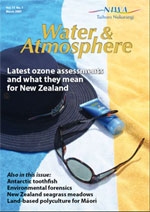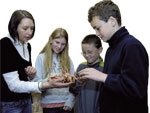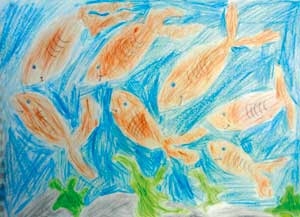PDF of this article (115 KB)


New scientist
Meet budding marine scientist Nathaniel Manning. This keen 12–year-old won the junior prize in the QTV online science quiz. The prize? Five days in the Bay of Islands studying bottlenose dolphins with Auckland University scientist Kirsty Russell. On this research trip, sponsored by the Ellerslie Rotary Club, Nathanial and Kirsty observed, photographed, and tracked populations of bottlenose dolphin around the Russell area.
In September 2006, Nathaniel and his family were given a guided tour of NIWA’s Wellington campus at Greta Point. Nathaniel’s favourite part of the visit was learning about the rock lobsters and their extraordinary ability to regenerate broken limbs, antennae, and damaged eyes. In the museum, Nathaniel was impressed by the deep-sea crabs and gigantic isopod. His interest in isopods has extended to a school project on the beasties. This is a young scientist in the making. Well done Nathaniel and keep up the good work.
QTV is the 13–part science series for kids that screened on TV1 early in 2006 and was partially funded by NIWA and the other crown research institutes. You can buy a DVD of the series and read more about Nathaniel’s trip on the QTV website. Plus, there are excellent science games, including ‘Decomposer’, ‘Pooface’, and ‘Deep-sea Explorer’.
For further information, contact: Megan Oliver, 0-4-386 0392, [email protected] QTV website: www.qteam.co.nz
Back to school for NIWA

In May 2006, Wellington’s Miramar Central School joined NIWA scientists aboard Tangaroa as they sailed to New Zealand’s Graveyard, a group of seamounts (undersea mountains) on the Chatham Rise. The name was apparently inspired by the horror film the first visitors were watching when they found this group of seamounts. However, to visit seamounts including Zombie and Gothic, the children did not even have to leave their classroom – instead taking a virtual voyage over the internet via daily ship–to–shore logs.
During the voyage, the website generated over 33 000 hits, with visitors following along almost in real time, able to join in the excitement as new species were discovered and deep-sea animals were observed in their natural environment.
In October, NIWA scientist Mireille Consalvey and Michelle Carter, a NIWA/Victoria University PhD student, visited Miramar Central School to tell the children more about the trip and life at sea. They began the afternoon by exploring New Zealand’s undersea environment, moving from shallow beaches down to the abyss, and travelling around our highly variable undersea terrain before stopping to look at seamounts in more detail.
The group of 9 and 10–year–olds watched as NIWA’s deeptowed camera was lowered to water depths of 1 km, and were able to see rare footage of the seafloor. They learned that corals are found not just in the tropics, but also in the deep sea, and about some of the many creatures that live on and around seamounts – ranging from orange roughy to giant squid.
Teacher Caragh Briggs says, ‘It was great to have real-life scientists at school as it gave the children an authentic learning experience. Hearing about what is being done by those people who are actually carrying out the research made it a real–life situation and not just something in a book or documentary.’ The visit stimulated a lot of discussion and artwork and provided the children with the opportunity to ask the scientists questions first hand. But they still couldn’t answer one question: ‘Is the Loch Ness Monster real?’
The voyage was funded by the Ministry of Fisheries and the Foundation for Research, Science and Technology; additional support came from the Census of Marine Life programme CenSeam, a global census of marine life on seamounts.
Read more about the trip at: censeam.niwa.co.nz/outreach/censeam_graveyard
For further information, contact: Dr Mireille Consalvey, 0-4-386 0853, [email protected]
Training at NIWA
Remaining courses for 2006/07:
Managing coastal hazards 20–21 March, Hamilton
Electric fishing machine operators 17–18 April, Christchurch
Identification of wetland sedges and rushes 2 days in May, Hamilton (see website for dates)
For further information, see: www.niwa.co.nz/edu/training or email [email protected]
